
LEDA 83677 is a lenticular galaxy located about 290 million light-years away in the constellation Coma Berenices. It is a member of the Coma cluster of galaxies. LEDA 83677 is also classified as a type 1 Seyfert galaxy. The core of the galaxy is emitting high-energy X-rays and ultraviolet light, probably caused by a massive black hole lurking in the core.

NGC 4488 is a lenticular galaxy located about 60 million light-years away in the constellation of Virgo. The galaxy was discovered by astronomer William Herschel on December 28, 1785. NGC 4488 is a member of the Virgo Cluster.

NGC 3805 is a lenticular galaxy located about 330 million light-years away in the constellation Leo. The galaxy was discovered by astronomer William Herschel on April 25, 1785. NGC 3805 is a member of the Leo Cluster.

NGC 3840 is a spiral galaxy located about 320 million light-years away in the constellation Leo. The galaxy was discovered by astronomer Heinrich d'Arrest on May 8, 1864. NGC 3840 is a member of the Leo Cluster. The galaxy is rich in neutral atomic hydrogen and is not interacting with its environment.
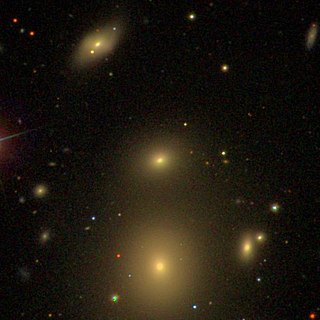
NGC 3841 is an elliptical or lenticular galaxy located about 300 million light-years away in the constellation Leo. It was discovered by astronomer John Herschel on March 25, 1827 is a member of the Leo Cluster.

NGC 3867 is a spiral galaxy located about 350 million light-years away in the constellation Leo. It was discovered by astronomer Édouard Stephan on March 23, 1884 and is a member of the Leo Cluster.
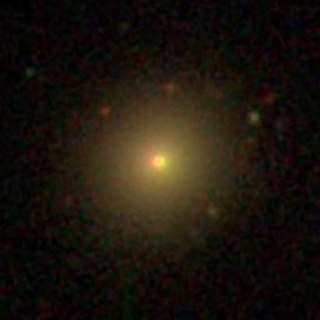
NGC 6053 is an elliptical galaxy located about 450 million light-years away in the constellation Hercules. The galaxy was discovered by astronomer Lewis Swift on June 8, 1886 and is member of the Hercules Cluster.
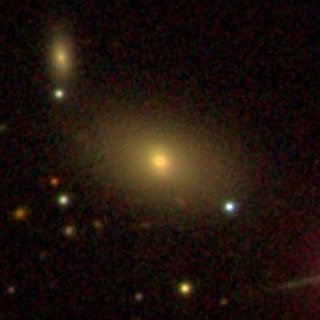
NGC 6054 is a barred lenticular galaxy located about 460 million light-years away in the constellation Hercules. It was discovered by astronomer Lewis Swift on June 27, 1886. It was then rediscovered by astronomer Guillaume Bigourdan on June 1, 1888. PGC 57073 is often misidentified as NGC 6054. NGC 6054 is a member of the Hercules Cluster.
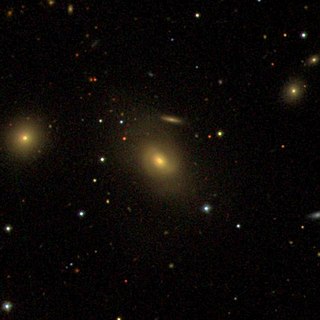
NGC 6055 is a barred lenticular galaxy located about 450 million light-years away in the constellation Hercules. The galaxy was discovered by astronomer Lewis Swift on June 8, 1886. It also a member of the Hercules Cluster and is a LINER galaxy.

NGC 6061 is a lenticular galaxy with radio activity located about 490 million light-years away in the constellation Hercules. The galaxy is classified as a head-tail radio galaxy and was discovered by astronomer Lewis Swift on June 8, 1886. NGC 6061 is a member of the Hercules Cluster.

NGC 3558 is an elliptical or a lenticular galaxy located 440 million light-years away in the constellation Ursa Major. It was discovered by the astronomer Heinrich d'Arrest on April 15, 1866. It is a member of the galaxy cluster Abell 1185 and is classified as a LINER galaxy.

NGC 688 is a barred spiral galaxy with starburst activity located 190 million light-years away in the constellation Triangulum. It was discovered by astronomer Heinrich d'Arrest on September 16, 1865 and is a member of the galaxy cluster Abell 262.

NGC 704 is a lenticular galaxy located 220 million light-years away in the constellation Andromeda. The galaxy was discovered by astronomer William Herschel on September 21, 1786 and is also a member of Abell 262.

NGC 4091 is a spiral galaxy located 360 million light-years away in the constellation Coma Berenices. The galaxy was discovered by astronomer Heinrich d'Arrest on May 2, 1864. NGC 4091 is a member of the NGC 4065 Group and is a LINER galaxy.

NGC 4084 is an elliptical galaxy located 315 million light-years away in the constellation Coma Berenices. NGC 4084 was discovered by astronomer Heinrich d'Arrest on April 26, 1865. NGC 4084 is an isolated member of the Coma Supercluster and is classified as a LINER galaxy.
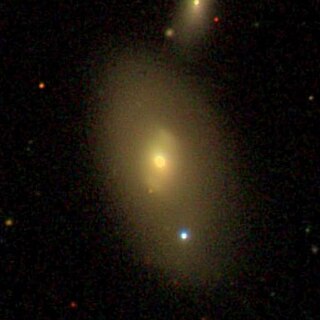
NGC 4296 is a barred lenticular galaxy located about 200 million light-years away in the constellation Virgo. It was discovered by astronomer William Herschel on April 13, 1784. It forms a pair with NGC 4297, and both galaxies are listed as CGCG 042-041, and KPG 331.

NGC 3925 is a barred lenticular galaxy and a ring galaxy located about 370 million light-years away in the constellation Leo. It was discovered by astronomer Heinrich d'Arrest on February 19, 1863.
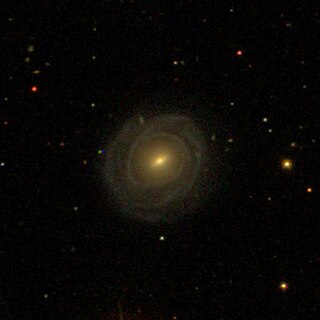
NGC 4326 is a barred spiral galaxy with a ring located about 330 million light-years away in the constellation Virgo. It was discovered by astronomer William Herschel on April 13, 1784, who described it as "vF, S, R, bM, 1st of 3". It is a large galaxy, with a diameter of around 200,000 ly (61 kpc) making it nearly twice the size of the Milky Way. NGC 4326 is also classified as a LINER galaxy. Despite being listed in the Virgo Cluster catalog as VCC 623, it is not a member of the Virgo Cluster but instead a background galaxy.

SDSSCGB 10189 is a trio of interacting galaxies that is located in the constellation of Boötes. They are located 1.04 billion light-years away from the Solar System and are gravitationally interacting.
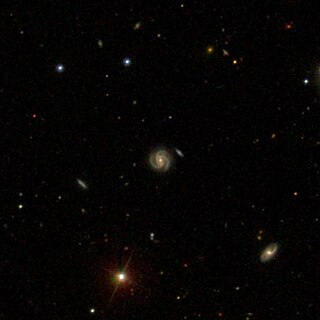
Arp 60 also known as PGC 1762846, is a barred spiral galaxy located in Coma Berenices. It is located 958 million light-years from the Solar System and has an approximate diameter of 95,000 light-years.




















